Related Products
For Professionals
- Amplification
- Assessment of Student Skills, Challenges, Needs
- Early Childhood: Infants, Toddlers, Preschool
- Hearing Loss – Identification, Impact and Next Steps
- IDEA Law Summary Information
- Language and Speech Development Issues
- Legal Issues in Serving Children with Hearing Loss
- Listening (Auditory Skills) Development
- Planning to Meet Student Needs
- Self-Advocacy Skills for Students with Hearing Loss
- Self-Concept: How the Child with Hearing Loss Sees Himself
- Social Skills
- Speech Perception & Learning
Related Teacher Tools Takeout Items
Demonstrations: Simulated Listening with Hearing Loss & Devices
Listening with Cochlear Implants
Listening with Auditory Neuropathy Spectrum Disorder
Demonstrations of the challenges of speechreading can be found HERE
Listening is hard work when you aren’t able to hear all of the speech sounds! Children with hearing loss are usually more fatigued than their typically hearing friends or siblings. For a brief article on this topic from Britain, download Tiredness in Deaf Children
Welcoming the Child with Hearing Loss into Child Care Not a simulation but good information to share with the parent and/or child care provider along with your suggestion to listen to a hearing loss simulation.
Thanks to all of the researchers who made these resources available!
 Simulating unilateral or mild hearing loss with families? Purchase a pack earplugs from us. . Experiencing the listening challenges is a valuable strategy for facilitating understanding of the importance of ‘little hearing losses.’
Simulating unilateral or mild hearing loss with families? Purchase a pack earplugs from us. . Experiencing the listening challenges is a valuable strategy for facilitating understanding of the importance of ‘little hearing losses.’
Visual Simulations of the IMPACT of Hearing Loss
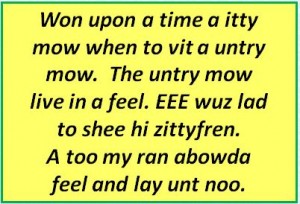 Simulations like the yellow story shown can be very effective in getting across the concept of being able to ‘hear’ but not fully understand or the time lag needed to integrate all of the pieces before comprehension occurs. ready-made handout
Simulations like the yellow story shown can be very effective in getting across the concept of being able to ‘hear’ but not fully understand or the time lag needed to integrate all of the pieces before comprehension occurs. ready-made handout
Another approach is to provide a visual representation of a student’s estimated access to verbal instruction as identified with the Functional Listening Evaluation.This story is based on The Country Mouse and the City Mouse
which which is well known by many teachers. Here are more visual analogies.
A ready made-handout showing classroom directions imposed over 100 puzzle pieces is a very effective way of visually showing the impact of hearing loss. Here is a handout with puzzle pieces that can be used to effectively report results of a Functional Listening Evaluation.
Simulation of Listening in Varying Classroom Acoustic Conditions
Quick 4-slide Demonstration Be sure to include this 4-slide PowerPoint show with embedded audio files as you inservice teachers. You must show it as a PowerPoint slide show to be able to hear the various simulations. It simulates the effects of distance, high and low frequency listening and reverberation. Classroom Acoustics 4 slides Our thanks to Phonak for the original materials.
Simulation of Listening with a Hearing Loss – via entering individual  audiogram
audiogram
- Hearing Loss Simulator Source: NIOSH / Centers for Disease Control. The National Institute for Occupational Safety and Health Hearing Loss Simulator (HLSim) displays a “control panel” for showing the effects of hearing loss visually on the frequency band control panel and sound level display screen while the user listens to the audio playback. For more information or to request a NIOSH Hearing Loss Simulator CD, contact NIOSH Mining at OMSHR@cdc.gov.
Simulations of Listening with a Hearing Loss (audio demonstrations with visuals)
- Hearing Loss Imposed on a Flintstones Cartoon (Mild – Severe Hearing Loss) Source: House Research Institute
- What does a hearing loss sound like? Source: National Institute for Occupational Safety and Health (NIOSH) / Center for Disease Control
Simulations of Listening with a Hearing Loss (audio recording demonstrations)
- Video of a sample spelling test with a mild hearing loss
- Simulations of Mild and Moderate Hearing Loss in quiet and various type of noise Source: HearingLikeMe
- Simulations of Normal Hearing, Mild Hearing Loss, & Moderate Hearing
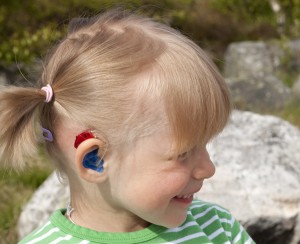 Loss under various noise conditions Source: Phonak – Understanding Hearing Loss
Loss under various noise conditions Source: Phonak – Understanding Hearing Loss - Simulations of normal hearing and moderate hearing loss in quiet and with background noise Source: Centers for Disease Control / National Institute for Occupational Safety and Health
- Simulations of Normal, Mild, Moderate, Severe hearing loss with different sound sources Source: Starkey
- “Classic” recordings from recordings from the 1970s, including the Unfair Spelling Test (Unfair Hearing Test)
- “Slight Hearing Loss” of about 20 dB
- “Mild Hearing Loss” of about 30 dB
- Normal hearing through 1000 Hz followed by a sloping high frequency hearing loss
- Normal hearing through 500 Hz followed by a sloping high frequency hearing loss
- An Unfair Spelling Test Answers to the Unfair Spelling Test
Simulations of Listening with a Hearing Loss through a Hearing Aid Microphone
-
- 6 minute recording, minutes 1-3 demonstrate use of hearing aids in a
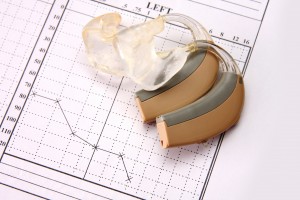 classroom setting Source: Jim Bombicino
classroom setting Source: Jim Bombicino
- 6 minute recording, minutes 1-3 demonstrate use of hearing aids in a
Recordings Demonstrating Listening Benefit Provided by FM Use (audio demonstrations with visuals)
Simulations of Listening with Auditory Neuropathy Spectrum Disorder
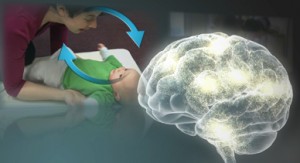
-
-
- Simulation of profound neuropathy then severe, moderate, mild and finally the recording without the ANSD simulation. Source: Details of this acoustic simulation can be found in a paper by Zeng, Oba, Garde, Sininger, and Starr (1999).
-
Simulations of Listening with a Cochlear Implant
Note: people who are born deaf and then get implanted at a young age and those who had normal hearing that progressed into deafness do not “hear” the way that the simulations below suggest. Given time, intervention, motivation and encouragement, the experience of listening through a cochlear implant results in the brain of the person adapting to the electronic input of a cochlear implant which often results in “hearing” with clarity that has been described as being similar to persons typical hearing. Cochlear implants do not result in, nor are they equal replacements for normal hearing. People who use cochlear implants will perceive sound at a loudness that is quieter than typical hearing and they will be significantly at a disadvantage when listening in noisy situations and at a distance. Of course vocabulary deficits, attention issues, and any area of educational delay will impact how well a person performs with a cochlear implant, regardless of how well or how clearly they “hear.”
-
-
- 1, 4, 8, 12 and 20 channel cochlear implant simulations for speech
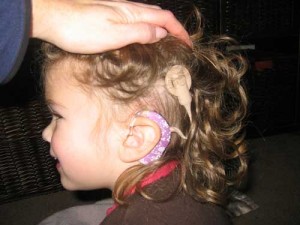 and music Source: The Hearing Journal published an article by Patrick M. Zurek and Joseph G. Desloge (of Sensimetrics Corporation) in its July 2007 issue entitled “Hearing loss and prosthesis simulation in audiology”.
and music Source: The Hearing Journal published an article by Patrick M. Zurek and Joseph G. Desloge (of Sensimetrics Corporation) in its July 2007 issue entitled “Hearing loss and prosthesis simulation in audiology”. - For an interesting video simulation of the advancements in cochlear implants, including improvements in speech understanding view this video.
- Simulation of listening with a cochlear implant to speech and to music – video
- More sophisticated than some of the others, the AngelSim cochlear implant hearing loss simulator allows you to select speech processing strategies and then audio samples so that what you hear may be much more similar to a particular student’s experience than more generic CI simulations.
- Cochlear Implant Simulation on Speech and How I Feel About my Implant (reuploaded)[CC] video
- 1, 4, 8, 12 and 20 channel cochlear implant simulations for speech
-
Updated October 2023

 Listening with Hearing Loss
Listening with Hearing Loss